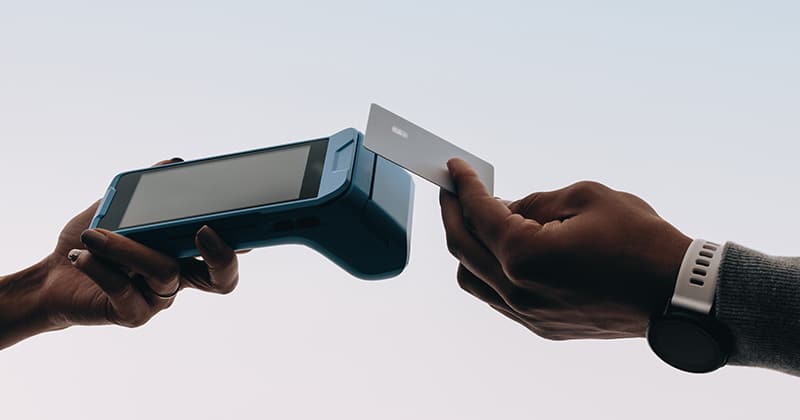How to Set Up Credit Card Processing for Electricians
According to a study by Forbes Advisor, only 9% of consumers primarily use cash or check to pay for their purchases. The rest usually use credit or debit cards.
So, accepting credit cards is an important way for service businesses to appeal to more customers. Plus, card payments are convenient and more secure than cash. And you can track revenue more easily. For instance, you can connect payment processing software to your accounting tools.
At the same time, credit card payment security is an issue for businesses. As Forbes notes, one-third of small businesses think card fraud is a major problem.
Payment processing problems can impact your revenue and profits. Card companies often fix such issues. But it can take months to get a resolution. This delay can impact cash flow and create budgeting problems.
In this article, we’ll look at why credit card payment security matters for contractors. Also, you’ll learn about industry security standards.
We’ll show you the methods for safeguarding your credit card processing system. Then, you’ll read about tips you can use today to start making your customers’ payments more secure.
RELATED ARTICLE: 8 Ways Going Cashless Will Improve Your Home Renovation Business
Why Credit Card Payment Security Matters for Your Contractor Business

Credit card processing issues can affect your company in several ways. Poor security practices can open the door to fraud. There is also an increased risk of data breaches.
Here is a closer look at the issues that could arise from poor credit card security.
- Loss of income: Cardholders usually aren’t liable for fraudulent charges or processing mistakes. The merchant (you) or the credit card issuer shoulder any losses due to such problems.
- Client mistrust: Clients may blame you if their financial data gets stolen. Such incidents could cause a lack of trust. Your image could suffer even if someone else is liable for the breach or fraud.
- Liability: As a business owner, you are responsible for secure payment processing. You need to follow the Payment Card Industry Data Security Standard (PCI DSS). Even if there is no security breach, noncompliance could lead to penalties.
- Loss of reputation: Customers expect contractors to be careful with their financial details. If a payment processing system looks insecure, it could damage your reputation. Customers may not trust you even if they don’t become fraud victims.
Good credit card security protects against these problems. It will also give you peace of mind. You won’t worry about causing issues for your customers or hurting your reputation.
Types of Credit Card Fraud Common with Contractors
Contractors are vulnerable to specific types of credit card fraud. Bad actors may be responsible for most fraudulent activity. However, you also need to be aware of disputes involving legitimate customers.
Consider the following issues if you accept credit card payments:
- Card-not-present (CNP) fraud can occur with online payments. It is easier for criminals to use stolen or fake numbers on your website. They don’t have to show you a physical card for verification.
- Chargebacks are sometimes known as “friendly fraud.” Legitimate customers may dispute payments with the credit card company. For example, they may claim you didn’t fulfill the contract. They can get the card company to stop payment while they challenge the charge.
- Skimming involves stealing payment data during a transaction. Hackers get access to your payment processing device and steal card information. They then use the numbers to make other purchases.
- Data breaches occur when hackers get into your system. For instance, they could exploit password weaknesses to get into your databases. All it takes is one insecure device or weak credential for hackers to do damage.
- Phishing and social engineering happen when criminals pose as legit businesses. They try to get you to unwittingly reveal login details. For example, they may ask you to “verify” customer payment details. If you do, they can use the details to make fraudulent purchases.
Large companies have IT and cyber security departments to protect against fraud. As a small business owner, you don’t have this luxury. You need to rely on your own systems and find trusted third parties to help with payment security.
RELATED ARTICLE: How To Write a Payment Reminder: Templates and Tips
Industry Standards for Payment Security: An Overview
Understanding industry payment processing and card security standards is a must for all business owners. This will help you assess your security practices to see how they measure up.
In particular, you’ll need to be familiar with the Payment Card Industry Data Security Standard (PCI DSS), which outlines the rules for secure card payments.
This standard includes a dozen best practices and more than 300 additional regulations. Your payment processor can handle most of the compliance details. But you need to make sure you’re working with a partner who understands every single rule.
Though the details can be complex, the PCI DSS has six main aims:
- Build and update secure payment processing systems and networks
- Protect customers’ financial information
- Have a plan to find and fix security weaknesses
- Create strong access controls and password protections
- Test and track systems and networks regularly
- Create and update an information security policy
All the practices within the PCI DSS serve one or more of these goals.
FROM ONE OF OUR PARTNERS: How To Accept Credit Card Payments On My Phone
6 Ways to Safeguard Credit Card Payments for Contractors

The PCI DSS offers a framework for protecting payments. It’s up to you to use these different practices to strengthen your system.
These six steps will help you limit the chances of data breaches and fraud. As a bonus, they can also make your customers feel confident in your security setup.
Encrypt Payment Data
Encryption scrambles card data so that no one can read it during transmission. Hackers can still steal encrypted data. However, they can’t see the numbers without the decryption key. So they can’t use the card details.
This extra layer of protection is essential for online payments. Your website’s payment page should have an HTTPS address. This means the site uses a secure sockets layer (SSL). SSLs encrypt data after the user enters it. The system sends a separate key so that the process can decrypt it.
Get Secure Payment Gateways
Payment gateways are applications that collect and send card information during a transaction. They serve several important purposes. First, payment gateways encrypt card numbers and CVV codes. Hackers cannot see this vital information even if they intercept it on the way to the card processor.
Gateways can also verify funds, check for fraud, and process payments without storing financial info.
You can integrate a gateway onto your website. The gateway handles processing so your customers never have to type details on your site.
Use Two-Factor Authentication
Hackers often try to exploit passwords. Secure login and password creation practices can help limit this problem. Two-factor authentication (2FA) can add another layer of protection.
2FA systems send a code to a phone, app, or email account. When you or an employee logs in, you need both a password and a 2FA code. These codes change with every login, so it’s impossible to steal or guess them.
With this extra layer, hackers cannot access your system even if they steal or guess the password.
Hire a PCI DSS-Compliant Payment Processor
Payment processors will have access to your customers’ financial information. If they lack the proper security, this data could be vulnerable.
Your payment processing partner should be PCI DSS-complaint. They should meet all the security requirements laid out in the standard.
Payment processors may be liable for non-compliance. But your customers trust you to choose the right partner. A failure to do so would reflect poorly on you, even if an instance of fraud isn’t your fault.
Train and Assess Employees
If you have employees who accept payments, you should train them to handle credit card information. For instance, teach them not to write down or save credit card numbers during processing.
You can also educate them on how to ensure their devices remain secure and updated. Additional training could include showing them how to use 2FA, update passwords monthly, and use password managers to create strong credentials.
Make Regular Software and System Updates
Software providers regularly update their products. Often, these improvements involve security fixes. Developers might spot a vulnerability and make changes to patch it.
Keep your software and point-of-sale devices updated. These fixes can plug potential security holes.
How can you guarantee timely updates? Sign up to get notifications about updates. Or, set the system to auto-install fixes as soon as they become available.
FROM ONE OF OUR PARTNERS: 5 Easy Ways to Accept Credit Cards
Steps to Take Now to Ensure Safe Credit Card Processing

Safe credit card processing requires finding and working with the right partner. You’ll also need to continuously assess and update your policies when needed.
This process is certainly necessary, but it will take time. Luckily, you can get started with protecting credit card transactions right away. These steps can set the stage for a comprehensive credit card security improvement.
- Strengthen passwords. Google says that half of cloud security breaches involve weak passwords. Get your employees to change or randomize their passwords to avoid this problem.
- Get customer feedback. Ask your clients what they think of your payment system. Their answers can help you decide if you need to make changes or find a new processing partner.
- Check for updates. Hackers exploit out-of-date systems and security software. Check right now to see if your payment software and processing devices are updated.
- See who can access financial data. Make a list of employees who handle financial info. These are the people who you can target for extra security training.